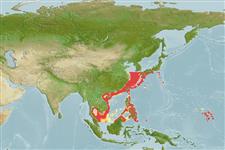Environment: milieu / climate zone / depth range / distribution range
Ecologie
marien demersaal; diepte 20 - 164 m (Ref. 9494). Tropical; 34°N - 4°N
Western Pacific: South China Sea north to China and Japan (Ref. 9774); also from the Philippines (Ref. 4537).
Grootte / Gewicht / Leeftijd
Maturity: Lm ? range ? - ? cm
Max length : 35.0 cm SL mannelijk / geslacht onbekend; (Ref. 9774); common length : 22.5 cm SL mannelijk / geslacht onbekend; (Ref. 9774); max. gerapporteerde leeftijd: 5 Jaren (Ref. 72462)
Dorsale stekels (totaal) : 0; Dorsale zachte stralen (totaal) : 77 - 89; Anale stekels: 0; Anale zachte stralen: 60 - 69; Wervels: 37 - 39. Body brownish, a distinct ocellus at junction of straight and curved parts of lateral line. Many dark rings scattered on body, many dark spots on median fins. A line connecting base of dorsal-fin ray and posterior nostril on eyed side passes behind posterior end of maxilla, or crosses its posterior part. Gill rakers moderately long and slender. Soft ray count of pectoral fin refers to that on ocular side (Ref 9774).
Inhabits mud and sand bottoms of shallow coasts or bays (Ref. 9774, 11230, 48637) to 164 m (Ref. 9494). Feeds on small benthic crustaceans and fishes (Ref. 9774). Also caught with small bottom trawls (Ref. 9774). Marketed mostly fresh (Ref. 9774).
Levenscyclus en paargedrag
Maturities | Voortplanting | Spawnings | Egg(s) | Fecundities | Larven
Distinct pairing (Ref. 205).
Masuda, H., K. Amaoka, C. Araga, T. Uyeno and T. Yoshino, 1984. The fishes of the Japanese Archipelago. (plates). Tokai University Press, Shinjuku Tokai Building. Tokyo, Japan. 437 p. (Ref. 711)
Status op de Rode Lijst van het IUCN (Ref. 130435)
Gevaar voor de mens
Harmless
Gebruik door de mens
Visserij: commercieel
Tools
Speciale rapporten
Download XML
Internetbronnen
Estimates based on models
Preferred temperature (Ref.
123201): 17.8 - 27.4, mean 23.9 °C (based on 197 cells).
Fylogenetische diversiteitsindex (Ref.
82804): PD
50 = 0.5000 [Uniqueness, from 0.5 = low to 2.0 = high].
Bayesian length-weight: a=0.00646 (0.00337 - 0.01237), b=3.14 (2.98 - 3.30), in cm total length, based on LWR estimates for this species & Genus-body shape (Ref.
93245).
Trofisch niveau (Ref.
69278): 4.0 ±0.66 se; based on food items.
Generation time: 3.5 ( na - na) years. Estimated as median ln(3)/K based on 1
growth studies.
Weerstandsvermogen (Ref.
120179): Hoog, minimale populatieverdubbelingstijd minder dan 15 maanden (K=0.31).
Fishing Vulnerability (Ref.
59153): Low to moderate vulnerability (35 of 100).
